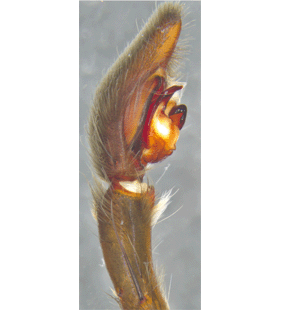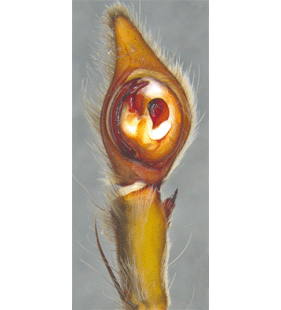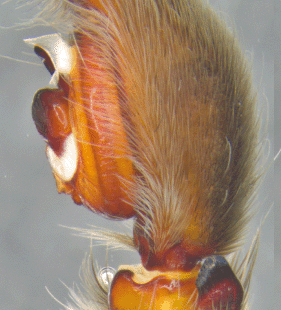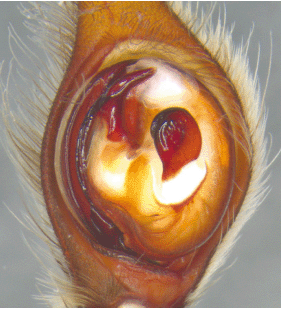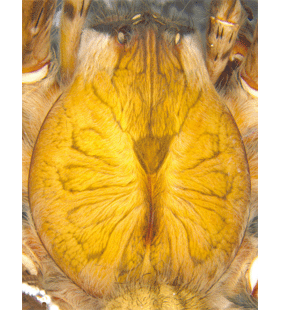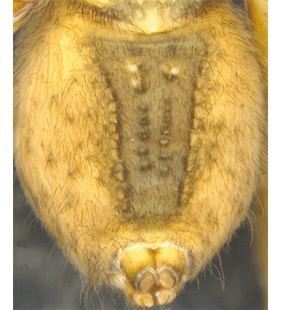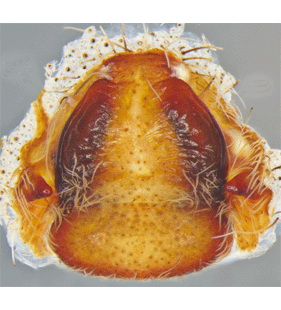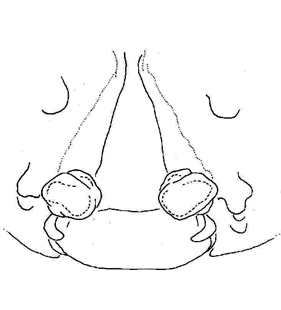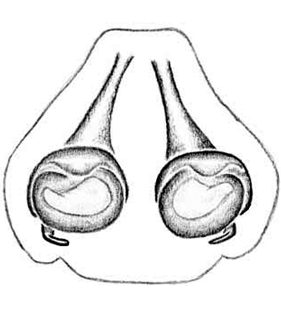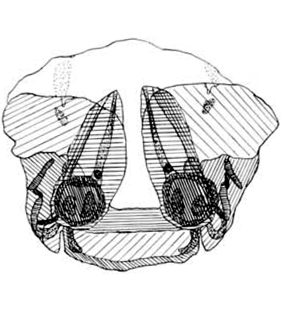Phoneutria boliviensis (F. O. Pickard-Cambridge, 1897)
Description
Male
Colouration very variable: prosoma, legs and sternum dark reddish brown, opisthosoma brown.
Body length male: 30-35 mmFemale
Prosoma yellowish to reddish brown with a thin black longitudinal stripe, black lines also lateral of the clypeus and dorsally on the pedipalpus, often yellowish banded. Opisthosoma dorsally yellowish with pairwise bright yellowish-brownish chevrons, ventrally gold to yellow with 2 rows of brown spots and 2 white spots. Chelicerae reddish to red brown, legs dorsally often with small yellow spots and thin black transversal stripes.
Body length female: 30-40 mmAdditional information
Non-established species in Europe (Nentwig, 2015).
This species of Central and South American origin is not native to Europe (alien species). It is rarely imported to Europe, usually with bananas from, but could not establish. This spider can bite humans. The following information concerns the closely related P. nigriventer (Bucaretchi et al., 2000) because toxicological information is rare for P. boliviensis. Prior to a bite, the spider may jump towards an approaching human, about 30 cm wide. Following a large Brazilian study, bites occur usually in feet or hands. In single cases, no venom is injected (dry bite) and in only 13% fang marks can be detected after a bite. Most bites cause only mild envenomation, usually strong local pain and small edema, lasting for a few hours. In rare cases systemic effects such as sweating or tachycardia can be observed. In only 1 % of cases, strong pain was reported, followed by sweating, tremor and vomiting. Such severe cases were restricted to children. Deaths are so far not yet reported for P. boliviensis.
Distribution
Figures
Distribution List
"No references" does not mean that the species does not occur in this country, but that we have not yet inserted the reference for it. We are working on it.
References
Bosmans R, Van Keer K (2017) Een herziene soortenlijst van de Belgische spinnen (Araneae). Nieuwsbrief van de Belgische Arachnologische Vereniging 32: 39-69 ![]()
Bucaretchi F, Deus Reinaldo C R, Hyslop S, Madureira P R, De Capitani E M, Vieira R J (2000) A clinico-epidemiological study of bites by spiders of the genus Phoneutria. Revista do Instituto de Medicina Tropical de São Paulo 42: 17-21 ![]()
Essl F, Rabitsch W (2002) Neobiota in Österreich. Umweltbundesamt, Wien, 432 pp. ![]()
Hazzi N A, Hormiga G (2021) Morphological and molecular evidence support the taxonomic separation of the medically important Neotropical spiders Phoneutria depilata (Strand, 1909) and P. boliviensis (F.O. Pickard-Cambridge, 1897) (Araneae, Ctenidae). ZooKeys 1022: 13-50 ![]()
Jäger P, Blick T (2009) Zur Identifikation einer nach Deutschland eingeschleppten Kammspinnenart (Araneae: Ctenidae: Phoneutria boliviensis). Arachnologische Mitteilungen 38: 33-36 ![]()
Nentwig W (2015) Introduction, establishment rate, pathways and impact of spiders alien to Europe. Biological Invasions 17: 2757-2778 ![]()
Noordijk J (2019) In Nederland geïmporteerde 'Braziliaanse zwerfspinnen' (Araneae: Ctenidae: Phoneutria) [Imported 'Brazilian wandering spiders' in the Netherlands]. Entomologische Berichten 79: 202-207 ![]()
Schmidt G (1954) Zur Herkunftsbestimmung von Bananenimporten nach dem Besatz an Spinnen. Zeitschrift für Angewandte Zoologie 36: 400-422 ![]()
Simó M, Brescovit A D (2001) Revision and cladistic analysis of the Neotropical spider genus Phoneutria Perty, 1833 (Araneae, Ctenidae), with notes on related Ctenidae. Bulletin of the British Arachnological Society 12: 67-82 ![]()
WSC (2025) World Spider Catalog. Version 26. Natural History Museum Bern, online at http://wsc.nmbe.ch (28.2.2025) doi: 10.24436/2 ![]()
Updates
| 17-11-2023 | Image insert | |
| 16-10-2023 | Distribution update | Detail |
| 16-10-2023 | Distribution insert | Detail |
| 01-03-2023 | Distribution insert | Detail |
| 11-03-2021 | Image insert | |
| 11-03-2021 | Distribution update | Detail |
| 23-01-2020 | Distribution update | Detail |
| 21-09-2019 | Datasheet update | Detail |
| 09-01-2019 | Distribution update | Detail |
| 09-01-2019 | Image insert | |
| 16-08-2017 | Distribution update | Detail |
| 16-08-2017 | Image insert | |
| 04-04-2017 | Image insert | |
| 04-04-2017 | Distribution update | Detail |
